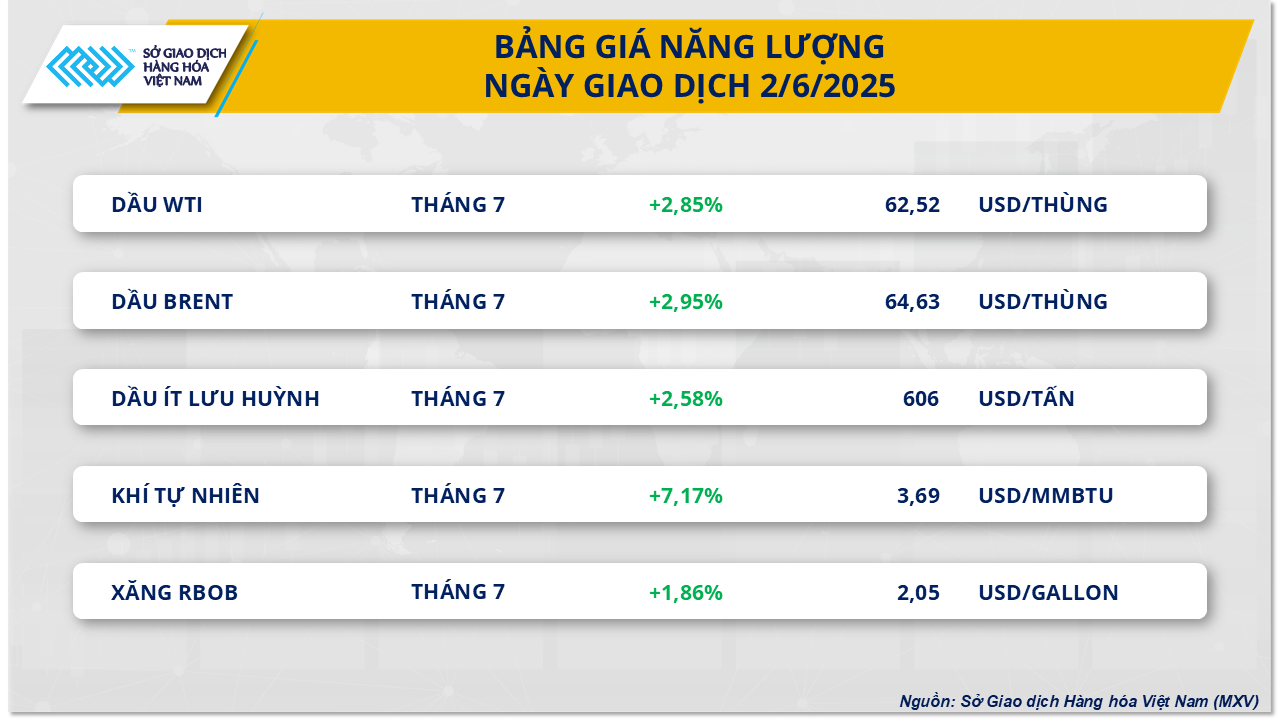In the energy market, at the end of the first trading session of the week, the energy market witnessed a strong increase in all 5 commodities in the group. In which, the price of two crude oil commodities simultaneously increased by nearly 3% despite the fact that the OPEC+ group will continue to increase production in July.
Specifically, WTI oil price recorded an increase of 2.85%, reaching 62.52 USD/barrel. Meanwhile, Brent oil price also increased from 62.78 USD/barrel to 64.63 USD/barrel, equivalent to an increase of up to 2.95%.
Last week, the Organization of the Petroleum Exporting Countries and its partners (OPEC+) officially decided to increase production for July by 411,000 barrels per day for the third consecutive month. Initial predictions of this increase in production have raised concerns about a global supply glut as the situation of some member countries exceeding their quotas has not been resolved.
However, according to analysts, many investors had expected an even higher production increase than the current one. Goldman Sachs predicted that August could become the fourth consecutive month that OPEC+ increased production by 411,000 barrels/day, with the reason given being the cyclical increase in consumption in the coming summer, which is also the peak travel season for Americans.
Last week, both the US Energy Information Administration (EIA) and the American Petroleum Institute (API) reported a sharp decline in US commercial crude oil inventories, while gasoline inventories also fell last week. This could lead the market to expect the start of a new cycle of fuel consumption growth in the US.

In addition, severe wildfires in three Canadian provinces, Manitoba, Saskatchewan and especially Alberta, have forced many oil companies to temporarily suspend operations. According to initial estimates, this could cause Canada's production to decrease by about 7% (equivalent to 344,000 barrels/day).
Meanwhile, the weakening of the greenback also supported the strong increase in oil prices. Accordingly, the US Dollar Index decreased by 0.63% in yesterday's session, making crude oil more attractive to investors holding other currencies. The continued complexity of the geopolitical situation, with disagreements between the US and Iran over the nuclear program, as well as tensions between Russia and Ukraine, further supported the increase in oil prices.
Regarding agricultural prices, according to MXV, red dominated the agricultural market in yesterday's trading session (June 2). In particular, soybean prices opened the new month in red, down 0.79% to $379/ton. In addition to favorable weather conditions in the US, the market was also under pressure from negative signals in US-China trade relations and the weakening of soybean oil prices.

According to the USDA Export Deliveries report, soybean deliveries for the week ending May 29 reached 268,343 tons, up from the previous week but still below the 361,000 tons in the same period last year. Although consistent with the current situation, this figure is not enough to support prices. The focus of the market is that China - the largest import partner of the US - has completed receiving the last soybean shipment for the 2024-2025 crop year without any new orders for the 2025-2026 crop year. This has shown that the trade relationship between the two countries is falling into a frozen state, creating negative sentiment in the market.
In addition, the weather conditions in the US continue to be favorable with mild temperatures, rain and sunshine evenly distributed over the next 10–14 days, creating ideal conditions for the early growth of soybeans. The market is currently forecasting the US soybean planting progress to be 85% complete – higher than the 5-year average and the same period last year, while crop quality this week is forecast at 67% good/excellent, reinforcing expectations for a bumper crop.
Source: https://baodaknong.vn/thi-truong-hang-hoa-3-6-dien-bien-tuong-doi-giang-co-254459.html


































































































Comment (0)